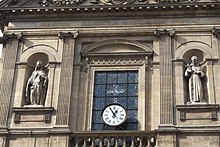Ste-Élisabeth (Paris)
The Catholic parish church of Sainte-Élisabeth at 195 rue du Temple in the 3rd arrondissement of Paris was built at the beginning of the 17th century as the church of a Franciscan convent . The nearest metro station is Temple on line 3 . In 1937 the church was included in the list of French architectural monuments as Monument historique .
history
At the beginning of the 17th century, the Franciscan Sisters received from the French King Louis XIII. permission to settle in Paris. In 1628, Maria de Medici , the king's mother, laid the cornerstone of the church. The construction work was probably carried out by Michel Villedo and Michel Noblet. In 1646 the future Cardinal von Retz, Jean-François Paul de Gondi , made the consecration . The church received the patronage of St. Elisabeth of Thuringia and was also consecrated to Maria ( Notre-Dame-de-Pitié ) as the second patroness .
During the French Revolution , the church was closed and used as a flour store. In 1802 it was consecrated again for worship and raised to the status of a parish church. In the first half of the 19th century, the church was enlarged by the architects Étienne-Hippolyte Godde and Victor Baltard . The nave was lengthened by a yoke , the semicircular choir with ambulatory and the south aisle were added. When the rue de Turbigo broke through in the course of the redesign of Paris under Prefect Haussmann , the monastery buildings had to give way and were demolished.
Since 1938, Sainte-Élisabeth has been a church of the Order of Malta , whose predecessor, the Order of the Templars , had a powerful commander in the nearby Square du Temple . The Sainte-Élisabeth Church is also the parish church of the first Chinese Catholic parish to settle in Paris after the First World War .
architecture
Exterior construction
The church faces west, contrary to the usual east . The entrance facade is two-storey and structured by fluted pilasters and niches that are filled with sculptures. Clearly protruding cornices run between the two floors and the arched gable . The gable is decorated with garlands that frame a cartridge with the letters SE .
The pilasters on the upper floor correspond to the Ionic order. The two sculptures are works by the sculptor Joseph Félon from 1863. They depict St. Elisabeth (left) and St. Francis of Assisi , the founder of the Franciscan order.
Six Doric pilasters on the lower floor support an architrave adorned with a triglyph frieze . The sculpture on the left of the portal represents Louis the saint , the right figure Saint Eugenia of Rome . They were created by Anatole Célestin Calmels in 1857. The tympanum with the relief of a Pietà was designed by Joseph Michel-Ange Pollet in 1860.
inner space
The nave has three aisles . The nave is provided with a groin vault covered and the two aisles by arched arcade separated. The latter rest on mighty pillars reinforced with Doric pilasters. A frieze with depictions of Christ's instruments of passion runs under the window area . Four massive columns with simple Doric capitals separate the choir from the ambulatory. The choir is vaulted with a semi - dome pierced by a skylight, which was painted by Jean Alaux (1786–1864) with a scene of the glorification of St. Elizabeth and her acceptance into heaven.
Leaded glass window
The leaded glass windows in the north aisle were created in 1827/28 by two English glass painters, Warren-White and Edward Jones, after boxes by Alexandre Abel de Pujol (1787–1861). They were originally housed in the Lady Chapel, which was demolished when the rue de Turbigo broke through. On the windows are John the Baptist , Saint Joseph with the baby Jesus and John the Evangelist .
Furnishing
Most of the church's furnishings were acquired in the 19th century.
- In the ambulatory there are 100 oak relief panels from 1627 with scenes from the Old and New Testament . They were originally located in the Saint-Vaast Abbey in Arras and are attributed to Laurent Gallet.
- In the south aisle there is a wood-carved Pietà from the 17th century.
organ
The organ was built in 1852/53 by Marie-Antoine-Louis Suret and his son Marie-François-Auguste. In 1941 and 1955 it was restored by Joseph Gutschenritter. The last restoration took place from 1994 to 1998 by the Giroud organ manufacturer. The organ is crowned by a sculpture of King David , who plays the harp and is surrounded by angels making music. The organ prospectus from 1853 was added to the list of monuments historiques in 1905, the instrumental part in 1980 . The instrument has 39 registers on three manuals and a pedal . The playing and stop actions are mechanical.
|
|
|
|
||||||||||||||||||||||||||||||||||||||||||||||||||||||||||||||||||||||||||||||||||||||||||||||||||||||||||||||||||||||||||||||||||||||
- Coupling : II / I, III / I, I / P, II / P
literature
- Georges Brunel, Marie-Laure Deschamps-Bourgeon, Yves Gagneux: Dictionnaire des Églises de Paris . Editions Hervas, Paris 2000 (1st edition 1995), ISBN 2-903118-77-9 , pp. 219-221.
- Jean Colson / Marie-Christine Lauroa (eds.): Dictionnaire des Monuments de Paris . Paris 2003 (1st edition 1992), ISBN 2-84334-001-2 , p. 669.
- Aline Dumoulin, Alexandra Ardisson, Jérôme Maingard, Murielle Antonello: Paris D'Église en Église . Éditions Massin, Paris 2008, ISBN 978-2-7072-0583-4 , pp. 65-68.
Web links
- Paroisse Sainte Élisabeth de Hongrie - Notre Dame de Pitié Text of the parish of Sainte-Élisabeth (French)
- Église Sainte-Élisabeth in the Base Mérimée of the French Ministry of Culture (French)
- Organ of Sainte-Élisabeth in the base Palissy of the French Ministry of Culture (French)
Individual evidence
- ↑ Église Sainte-Élisabeth in the Base Mérimée of the French Ministry of Culture (French)
- ↑ More information about the organ ( Memento from June 30, 2012 in the web archive archive.today )
- ↑ Comprehensive information on the organ
Coordinates: 48 ° 51 '58 " N , 2 ° 21' 38" E






